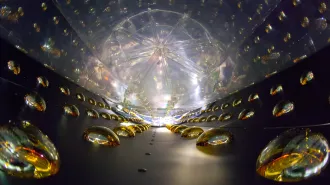The Super-Kamiokande neutrino detector has been indefinitely dry-docked after a major accident on Nov. 12 destroyed much of its costly hardware. The crippled facility, part of the Kamioka Observatory, lies about 180 miles northwest of Tokyo and more than half a mile underground.

The catastrophe struck as scientists refilled the detector’s 10-story chamber with water following maintenance work. Nearly 8,000 of the 11,200 photomultiplier tubes that line the inside of the domed steel vault suddenly imploded. The tubes, which each enclose a vacuum, measure the direction and intensity of light that neutrinos release as they move through the water-filled chamber.
The initial implosion of a single 20-inch-diameter tube may have set off a chain reaction, says Henry W. Sobel of the University of California, Irvine, a representative of Super-Kamiokande. At about $3,000 per tube, the cost of replacement could approach $30 million.
“We will rebuild the detector,” declared Yoji Totsuka, director of the Kamioka Observatory, in a statement published shortly after the accident. The observatory is operated by the University of Tokyo’s Institute for Cosmic Ray Research and an international consortium of over 20 organizations.
The detector is most famous for startling results garnered 3 years ago suggesting that neutrinos have mass (SN: 6/13/98, p. 374). Approximately 2 more years’ of data are needed from the detector to confirm the finding, which counters the long-held belief that neutrinos are massless. For the ongoing experiment, researchers direct a beam of neutrinos to the Super-Kamiokande detector from a physics facility about 150 miles away.
Totsuka says this experiment can be restarted, perhaps within a year, using only about half of Super-Kamiokande’s full complement of photomultiplier tubes. Other experiments were in progress at the time of the accident. Most will fall behind schedule but otherwise won’t be compromised by the shutdown, says Sobel.
Super-Kamiokande’s interrupted vigil for neutrinos from a supernova, however, could mean missed data-gathering opportunities. The project is designed to register the burst of neutrinos emitted by a star when it explodes. The detector, operating since 1996, has yet to record one of these events. “It would be very unfortunate if a supernova occurs while we are off the air,” says Sobel.
The other ongoing experiments, which include one that is monitoring neutrinos from the sun, may be restarted in Super-Kamiokande using a limited number of photomultiplier tubes. The detector’s quality of data on neutrinos coming from the sun and from any supernovae, however, mostly likely will be compromised by the reduced number of functioning tubes.
An upcoming experiment in which Super-Kamiokande is slated to receive neutrinos generated by the Japanese Hadron Facility (JHF) will have to await replacement of the tubes. Totsuka says the Super-Kamiokande detector “will be ready by the time of the commissioning of the JHF,” which is currently scheduled for 2007.







